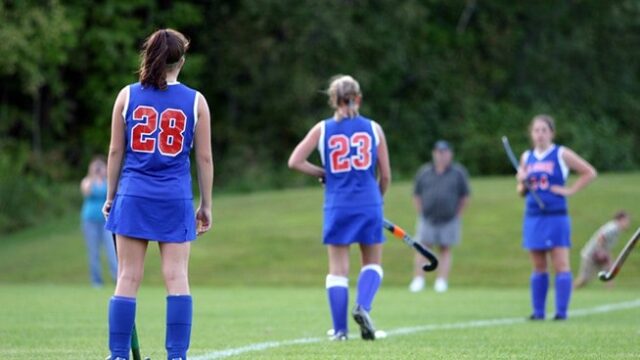Hockey is an intermittent field team sport: players walk, jog, run and sprint in different directions over the course of the 70-minute match, covering between 8-11 km. The goalkeeper is the only one of the eleven players who stays in a small area and requires a different type of fitness than the outfield players. The game requires high levels of endurance as well as the ability to accelerate, brake and change direction. Players have to bend low to play the ball and withstand the contact from their opponents when competing for the ball.
Weight training can help the players reduce the risk of non-contact injury, improve their deceleration and their acceleration. Traditional strength training often adds mass to the players’ bodies that they then have to carry around over 11 km. A balance must be found that gets the players as strong as they can, without getting too heavy, whilst being able to run well and be agile. Copying the football players’ weight training program would be unsuitable.
The Key Areas
Before lifting weights, the developing player, or novice adults, should undergo a foundational training program as outlined here:
Once this has been followed and the athlete can move well, then they can start to do more specific work with weights.
The common injury areas for field hockey players are the back, pelvis, knee and hamstrings. A combination of body weight and weight training exercises can be used to help reduce these injuries.
Hip series 1
Hip series 2:
Hip series 3
Hip hinge
Bent over row
Single-leg Squats
Hop and Hold
You will notice that most of these exercises combine balance, control and mobility. The exception is back strength. That is because the muscles do not require strength in isolation: they have to be able to support the body in the various different hockey positions and at speed. This requires balance and control and mobility.
The bent-over row and hip hinge can be done with either barbell or dumbbells, whichever is convenient. A starting place of 3 sets of 5-8 repetitions is enough for the weights exercises, 5 is enough for the body weight. Pull-ups are harder and the athlete may need to start with a jump pull-up and then lower slowly until they are strong enough to pull themselves up unaided.
The two sequences of exercises above can be done before or after a running session or hockey practice. They could also be done before a more generic weight training session.
These exercises are examples of what can be done and other, similar exercises, can be introduced throughout the season to add variety and stimuli.
Additional Exercises
Once the key areas have been trained regularly, additional can be introduced to further develop the athletes’ performance.
Lunge and Press: this can be done pitch side with a water bottle or in the gym with a light dumbbell. It replicates the different planes of movement that the hockey players need to get into. See the video for sets/ reps.
Back Squat: to help the athletes with acceleration from a low position. A full range of movement with control should always be the priority. 2 sets of 8-10 repetitions to start and then build to 3 sets of 5-6 reps with a heavier load. Squats are a great way of adding unnecessary mass. They are a staple for bodybuilders, so limit the weight used. Remember how much running is required in hockey.
Squat Jumps: use dumbbells in each hand. This can be done in between sets of back squat or afterwards. Jump as high as you can and land quietly with ankles, knees, and hips bent. This helps with braking mechanics that help you to stop fast and safely. 2-3 sets of 4-5 repetitions, ensuring correct landing and height, is a good start. If you can barely get off the ground, lower the weight.
Summary
Hockey, like all sports, requires its players to be strong. However, they also have to be good at running and sprinting and fast enough to make plays at the end of the match. Weight training should supplement the hockey practice and running sessions. The aim is not to be ‘strong in the gym’ but ‘strong enough’.
This content was originally published here.









